Your cart is currently empty!
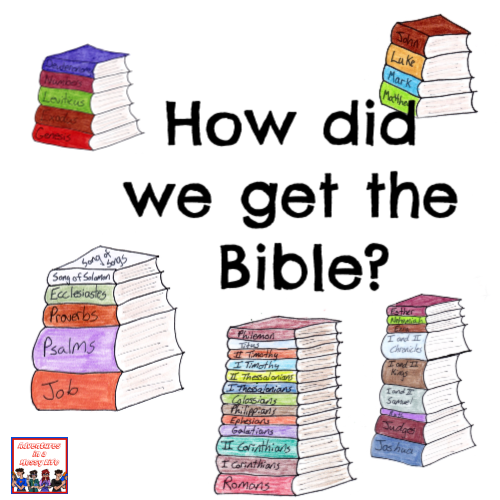
How did we get the Bible lesson for elementary
Tomorrow my church starts a new ministry year. That means we get a whole new Sunday School class, okay, only half new. The 4th graders we will have had the year before as 3rd graders. That also means our boys will be in our class for the first time. You will not believe how incredibly excited about this they are. Our first lesson of the year is “How did we get the Bible?” I’m super excited to teach it for the first time.
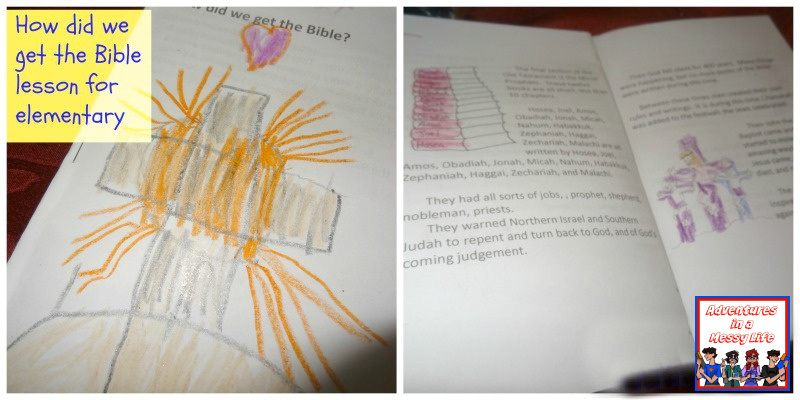
How Did We Get the Bible? lesson supplies
Just the booklet: “How did we get the Bible?” I printed it out as a booklet, and that takes up substantially less paper.
Teaching the actual How Did We get the Bible lesson

First, you need to set the framework for the Bible. The Bible is not just one giant book that is good for pressing flowers. It’s actually 66 books put together, they range in size from 1 page (Jude) all the way up to about 150 pages (Psalms).
The other thing that’s unique about the Bible is it was written over 4000 years of time. That’s part of what makes the Bible so amazing, despite being written over a large period of time there are no major contradictions (there are some differences in numbering that can be attributed to rounding in most cases).
A quick breakdown of the different parts of the Bible

The first 5 books of the Bible are the books of the Law. Moses wrote them and this sets up the framework of the nation of Israel.
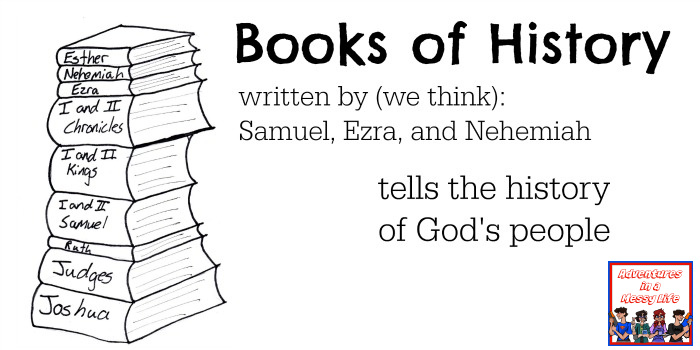
This covers the time from Joshua up through the building of the second temple. These cover the history of God’s people and the story of how God is moving towards Jesus.
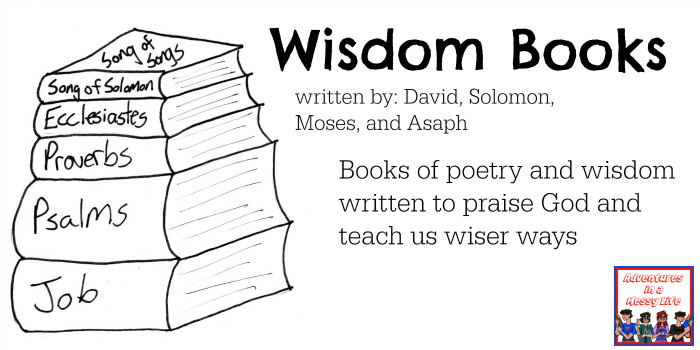
Poetry…… Oh wait that doesn’t really tell you what these books are, okay…. these are the books that offer us wisdom about God and the wise way to live our lives.

The major prophets so-called because they are longer than the minor prophets. They give warnings to God’s people and the surrounding nations of what God plans to do.
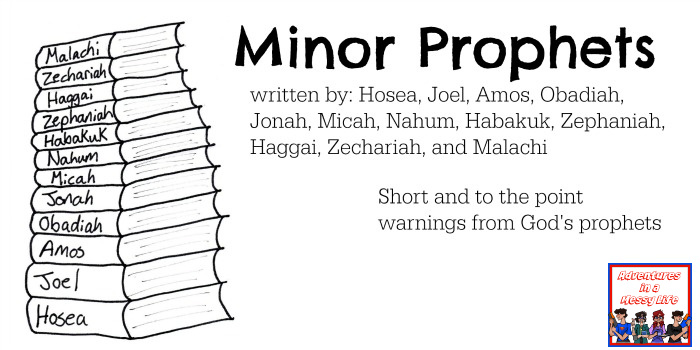
Minor prophets have a shorter message to deliver. They are under 10 chapters each and are usually to one specific people group.

The Gospels are the first 4 books of the Bible. They tell the story of Jesus’ life on earth. They are followed by the one book of history, Acts. Acts covers the history of the early church.

The New Testament Letters are written to churches and individuals in the early church instructing them and answering questions about how to follow Jesus.

The last section and the last book of the Bible is prophecy. The book of Revelation tells what is going to happen someday.
But all of this doesn’t answer, how did we get the Bible?
You’re right, but you needed that background information before I could answer that. Before Jesus was born the Old Testament was pretty much settled, around the time of Ezra and Nehemiah they had pretty much agreed on what the Jews considered cannon.
Fast forward 500 years or so and all of the first-century believers are starting to die, and people are starting to argue over what books constitute what we believe and what is inspired by God. I mean Paul wrote a lot of letters. A lot, we know of at least 2 more letters that didn’t make it into the Bible. Then what about these other gospels floating around should we include them?
So, the church leadership got together and came up with a standard for what should and should not be included:
- The author either knew Jesus personally or was trained by someone who had met Jesus personally. Matthew, John, Paul, James, Peter, and Jude all knew Jesus personally. Mark was trained by Peter, and Luke interviewed and followed Paul around for years.
- What did the book say? Did it agree with the rest of the Bible? This is where most of the gnostic gospels were thrown out, so goodbye gospel of Thomas, goodbye gospel of Judas.
- Did most church fathers agree with its usefulness? Does it have widespread approval? This is where the church starts arguing for the next 150 years about the last few books. Most of them were a quick approval process, but Hebrews, Jude, Revelation, and one or two others had a lot of back and forth discussion on the whole thing.
Finally, about 400 AD the church fathers all get together and agree at the Council of Hippo on the final official count for the New Testament.
Getting ready for a new ministry year

I’ve spent the last hour or so putting together the stuff for our lesson and drafting my kids for slave labor (open this package, do this). We’ve got books of the Bible cards, lessons printed off for them to take home, prayer journals all put together to give out.

I’ve printed off, chopped up, and laminated Books of the Bible cards for the kids to put in order and to practice looking up Bible verses, you can get them for free if you subscribe to my newsletter.
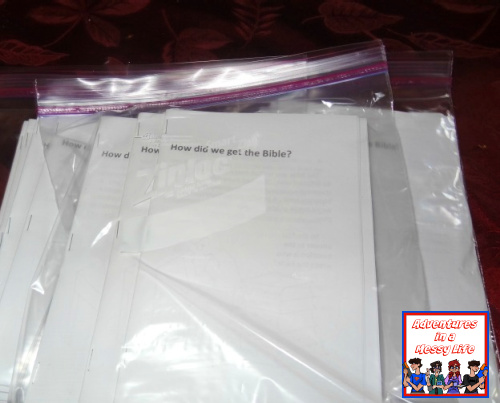
I’ve discovered stapling over and over and over again can be a good exercise for your arms, as I stapled the 30 “How We Got the Bible” lesson books {link goes to the lesson, yes I want to make sure you get it ![]() }. Also waiting for a copier to make all the copies and get it to work was a good test of my patience.
}. Also waiting for a copier to make all the copies and get it to work was a good test of my patience.
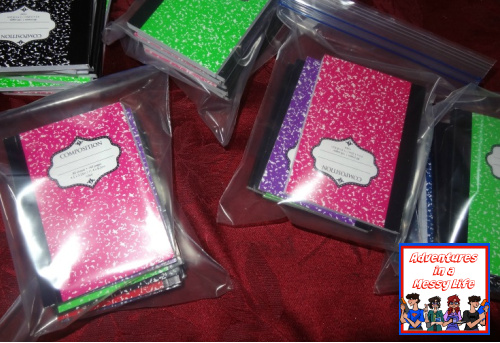
Prayer journals for the new year are all bagged up. We try at the end of each week to write down prayer requests in our prayer journals. The kids get an M&M if they bring their Bible and another one for bringing their prayer journal. We’re firm believers in rewarding participation, and I figure a few M&M’s won’t ruin their teeth.

Comments
10 responses to “How did we get the Bible lesson for elementary”
Blessings on a new year! Love the little prayer journals, and my kids dentist says chocolate (like m&ms) is the best candy for teeth because it doesn’t stick! 😉
So, the candy we’re using is about 50/50 on “goodness” scale. It’s M&Ms, runts (good), skittles, jelly beans (not so good).
Thanks for the printable – great job, as usual!
Love the prayer journals and your from the heart post Ticia (as always!)
Thank you so much! Our little church does not have much money and your freebie and lessons will go a long way in helping me to teach the little ones!!!
So glad to hear that!
There was a constant history of faithful people from Paul’s time through the Apostolic and Post Apostolic Church.
Melito, bishop of Sardis, an ancient city of Asia Minor (see Rev 3), c. 170 AD produced the first known Christian attempt at an Old Testament canon. His list maintains the Septuagint order of books but contains only the Old Testament protocanonicals minus the Book of Esther.
The Council of Laodicea, c. 360, produced a list of books similar to today’s canon. This was one of the Church’s earliest decisions on a canon.
Pope Damasus, 366-384, in his Decree, listed the books of today’s canon.
The Council of Rome, 382, was the forum which prompted Pope Damasus’ Decree.
Bishop Exuperius of Toulouse wrote to Pope Innocent I in 405 requesting a list of canonical books. Pope Innocent listed the present canon.
The Council of Hippo, a local north Africa council of bishops created the list of the Old and New Testament books in 393 which is the same as the Roman Catholic list today.
The Council of Carthage, a local north Africa council of bishops created the same list of canonical books in 397. This is the council which many Protestant and Evangelical Christians take as the authority for the New Testament canon of books. The Old Testament canon from the same council is identical to Roman Catholic canon today. Another Council of Carthage in 419 offered the same list of canonical books.
Since the Roman Catholic Church does not define truths unless errors abound on the matter, Roman Catholic Christians look to the Council of Florence, an ecumenical council in 1441 for the first definitive list of canonical books.
The final infallible definition of canonical books for Roman Catholic Christians came from the Council of Trent in 1556 in the face of the errors of the Reformers who rejected seven Old Testament books from the canon of scripture to that time.
There was no canon of scripture in the early Church; there was no Bible. The Bible is the book of the Church; she is not the Church of the Bible. It was the Church–her leadership, faithful people–guided by the authority of the Spirit of Truth which discovered the books inspired by God in their writing. The Church did not create the canon; she discerned the canon. Fixed canons of the Old and New Testaments, hence the Bible, were not known much before the end of the 2nd and early 3rd century.Thanks for giving more information, I knew some of that, but other was new to me.
So excited about this! Thanks!
Thanks so much for these resources to teach the Bible to kids. I am new in this so anything really helps! Looking forward to finding more materials and craft ideas for the lessons to come.

Leave a Reply